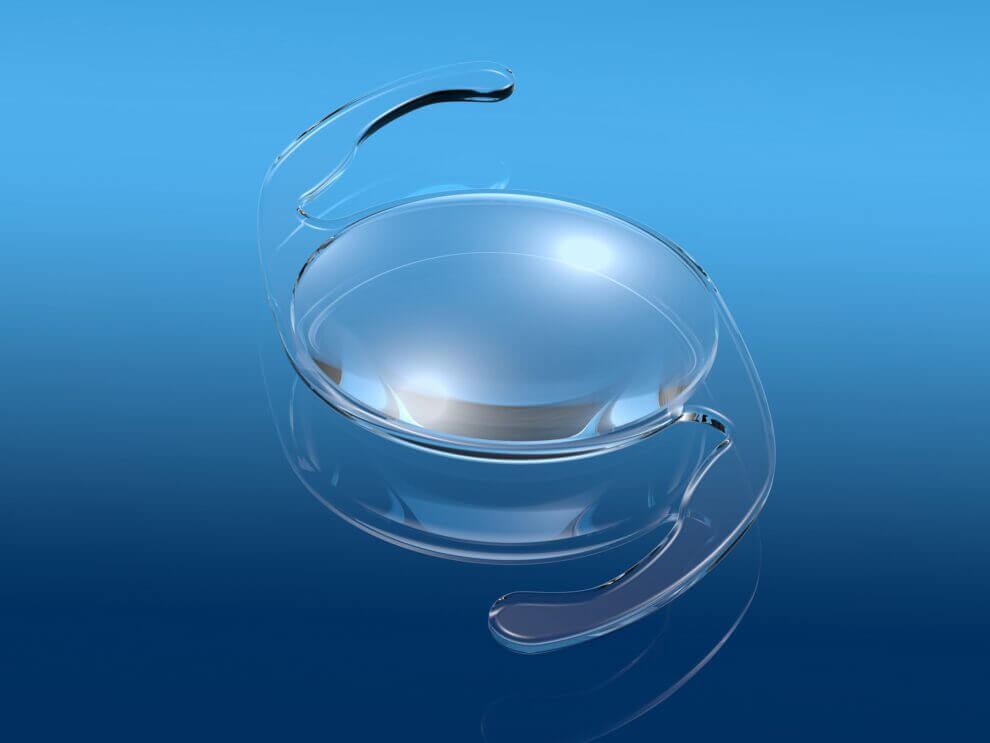What Are Cataracts?
Cataracts are a condition in which the lens of the eye (which resides behind the colored iris) becomes cloudy, leading to blurry vision. The lens, which is normally clear, helps focus light on the retina in the back of the eye. Over time, due to aging, genetics, or other factors, proteins in the lens can clump together, causing the lens to become opaque or cloudy. This cloudiness interferes with light reaching the retina, making vision less clear.

Symptoms of Cataracts
Cloudy of blurry vision, trouble seeing at night, light and glare sensitivity, seeing “halos” around lights, fading or yellowing of colors, and double vision in one eye.






How Cataracts Are Corrected?
The primary treatment for cataracts is surgery. Cataract surgery involves removing the cloudy lens and replacing it with an artificial intraocular lens (IOL). The procedure takes about 5-10 minutes and is generally straightforward, safe, and highly effective.
The Surgery Process
1. Preparation
The patient receives eye drops to dilate the pupil and numb the eye.
2. Removal of the Cloudy Lens
The surgeon creates two tiny self-sealing incisions in the eye and uses ultrasound to break up (emulsify) the cloudy lens into small pieces which are then easily removed from the eye with a specialized probe.
3. Replacement
Once the cloudy lens is removed, the surgeon inserts an artificial intraocular lens (IOL) into the eye. The IOL helps focus light onto the retina and restore clear vision.
4. Recovery
The surgery is done on an outpatient basis, meaning you can go home the same day. After the procedure, you may be prescribed eye drops to prevent infection and reduce inflammation. However, most cataract surgeries done at Batchelet Eye do not require the use of anything but artificial tears after surgery.
In cases where cataracts are in both eyes, surgery is performed on one eye at a time, with a gap between the surgeries. Cataract surgery is very common and has a high success rate, with most people experiencing significant improvements in their vision afterward. Dr. Batchelet has performed over 20,000 cataract surgeries and is one of the most experienced surgeons in the country.
Are You a Good Candidate for Cataract Surgery?
Take Our Cataract Self-Test and Find out!
Will I Need Drops After Cataract Surgery?
Dr. Batchelet specializes in Dropless Cataract Surgery. The traditional method for postoperative care after cataract surgery involves the use of topical antibiotic, steroid and nonsteroidal anti-inflammatory drops. The problem with this method is that over half of cataract patients, it is believed, cannot properly use the drops as prescribed. Due to this, Dr. Batchelet switched to delivering the needed medications into the eye at the end of surgery many years ago. It is a method that has been used all over the world for many years but is still considered off-label by the FDA. This means that it is not specifically approved for use. However, many current treatments fall into the same category throughout medicine.
Dr. Batchelet has utilized this method more than 15,000 times without a single postoperative infection. To be clear, infection is always a risk for any surgery including cataract surgery. Dropless surgery doesn’t guarantee protection from infection. However, this method is extremely effective, free to the patient and a great deal easier than using drops. There are still some patients and situations where Dr. Batchelet will want to use drops after surgery.
Lens Options
After cataract surgery, the cloudy natural lens is replaced with an intraocular lens (IOL), which helps restore clear vision. There are several types of IOLs available today, each with unique features that address specific vision needs. Modern IOL options offer improvements in visual clarity and reduce the need for glasses after surgery. Below are the main types of IOLs and packages:
Standard Lens Option
This type of IOL is designed to focus light at a single distance—either near, intermediate, or far. Many people choose distance vision, requiring glasses for near or intermediate tasks like reading. People who are used to reading without glasses will often choose to maintain this ability. However, due to astigmatism (a mild “football” shape in the cornea of your eye) and other factors, people who choose this lens option MUST be prepared to wear spectacles at ALL TIMES after cataract surgery even if you didn’t need them for certain activities in the past. This lens implant is the only one covered by Medicare and other insurances.

Custom Lens Packages
The options below offer significant visual improvement over the Standard Lens Option, but there is an additional out-of-pocket fee that is required in addition to any copays, coinsurance and/or deductibles. Not every patient is eligible for all the following choices. Dr. Batchelet will help guide you through the options that will work best for you.
Clarity Package
The lenses in this category are also known as Toric IOLs and are designed to correct astigmatism, a condition where the cornea has an oblong “football” shape, causing blurry or distorted vision. These IOLs have different powers and are designed to be lined up with specifically with the “laces of the football” to correct the vision. After a Toric lens is implanted most patients no longer require glasses for distance vision. Glasses for reading and intermediate (computer/dashboard) vision will still be required. This lens may require additional corneal laser surgery in a small percentage of patients.
Unity Package
This package includes two main types of lenses. Each has a unique structure with different focusing characteristics, allowing for clear vision at varying distances (near, intermediate, and far) with a much-reduced need for glasses. These lenses may require additional corneal laser surgery in a small percentage of patients.
1. Trifocal IOL- An advanced IOL designed to provide vision at three different focal points: near, intermediate, and far distances. Trifocal lenses aim to provide a wider range of vision with minimal use of glasses most of the time. There will still be activities and situations where you will need to wear glasses, including reading in low light environments.
2. Extended Depth of Focus (EDOF) IOLs- EDOF lenses are designed to provide a continuous range of vision, from distance to intermediate (computer/dashboard) by stretching the focus. They don’t have distinct zones like trifocal lenses but are designed to give clearer vision at intermediate and distance ranges with some near vision improvement. There will still be a need for reading glasses for near vision tasks and other situations as well.
Infinity Package
This package includes an implant and technology known as the Light Adjustable Lens (LAL). The LAL is the only lens that can be adjusted after implantation using a specific wavelength of light. After the lens is inserted, Dr. Batchelet can painlessly fine-tune the focusing power of the IOL to provide the best vision for the patient. This lens can often be adjusted to provide distance and intermediate (computer/cell phone) vision. The LAL provides the most precision in achieving desired visual outcomes of any lens type with the least possibility of unwanted visual side effects.
Choosing the Right IOL
The choice of IOL depends on various factors, including: Cost- a great deal of the decision comes down to this. If you can afford a custom lens and wish to reduce your need for glasses, that is usually the answer. There is very little else you can spend money on that will have a greater impact on your life than reduced dependence on glasses. Your lifestyle- perhaps your daily activities are made more difficult with the use of glasses or vice versa. Previous Eye Surgery or Conditions: Conditions like previous LASIK, trauma, astigmatism, macular degeneration, or dry eye disease can influence which IOL is best suited for you. Surgical considerations: Some IOLs require more precise positioning and may not be appropriate for all patients.
Financing Options
Frequently Asked Questions

